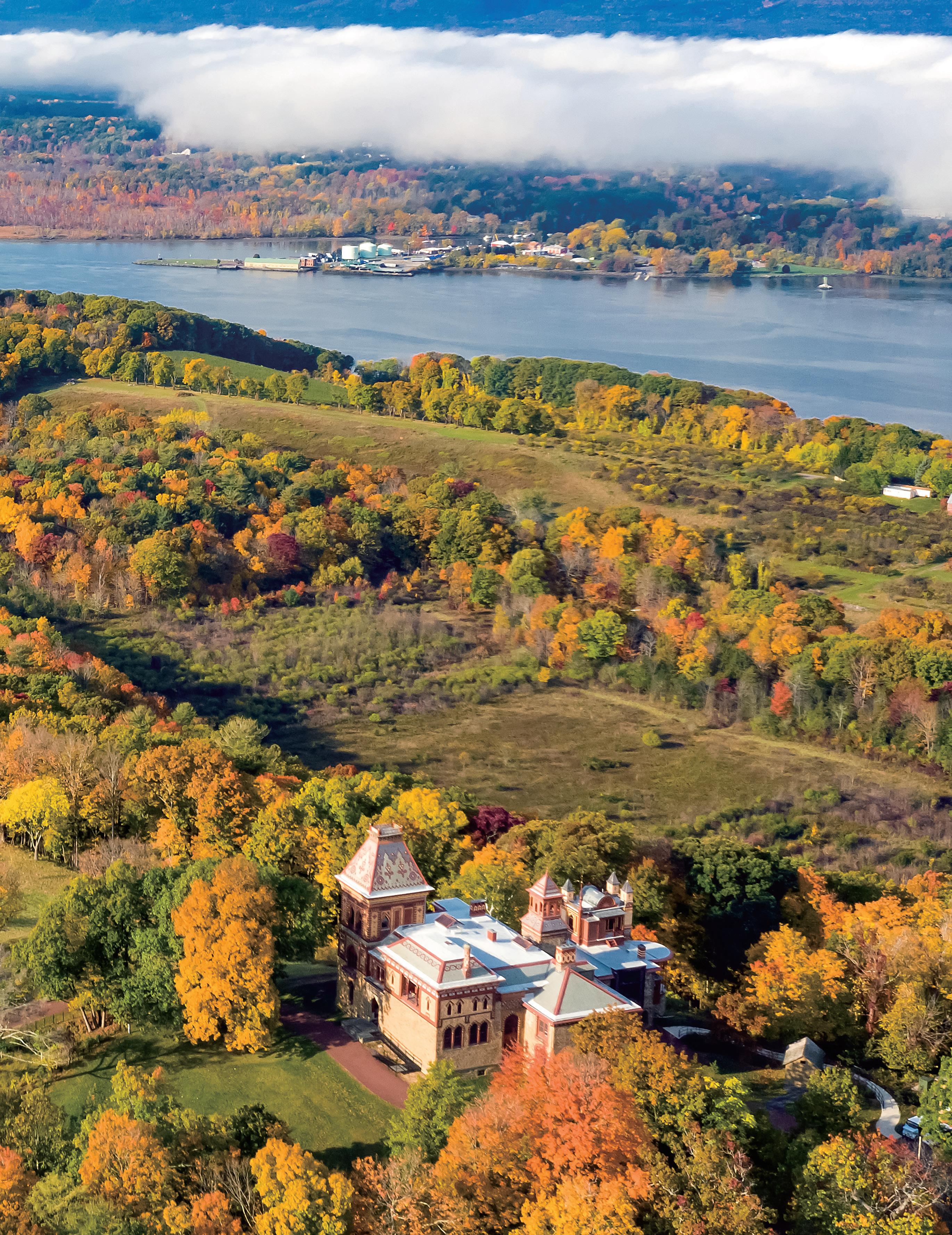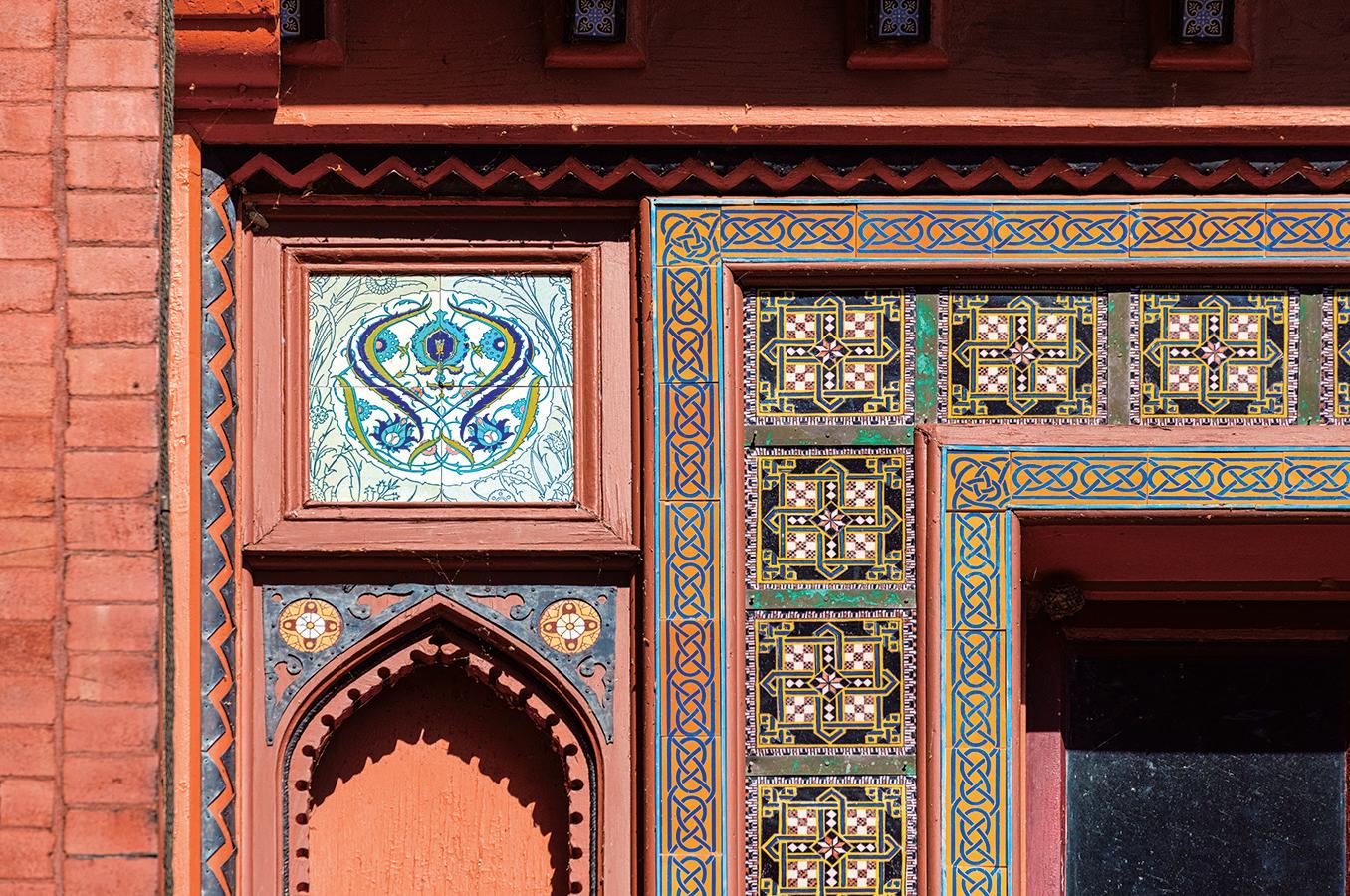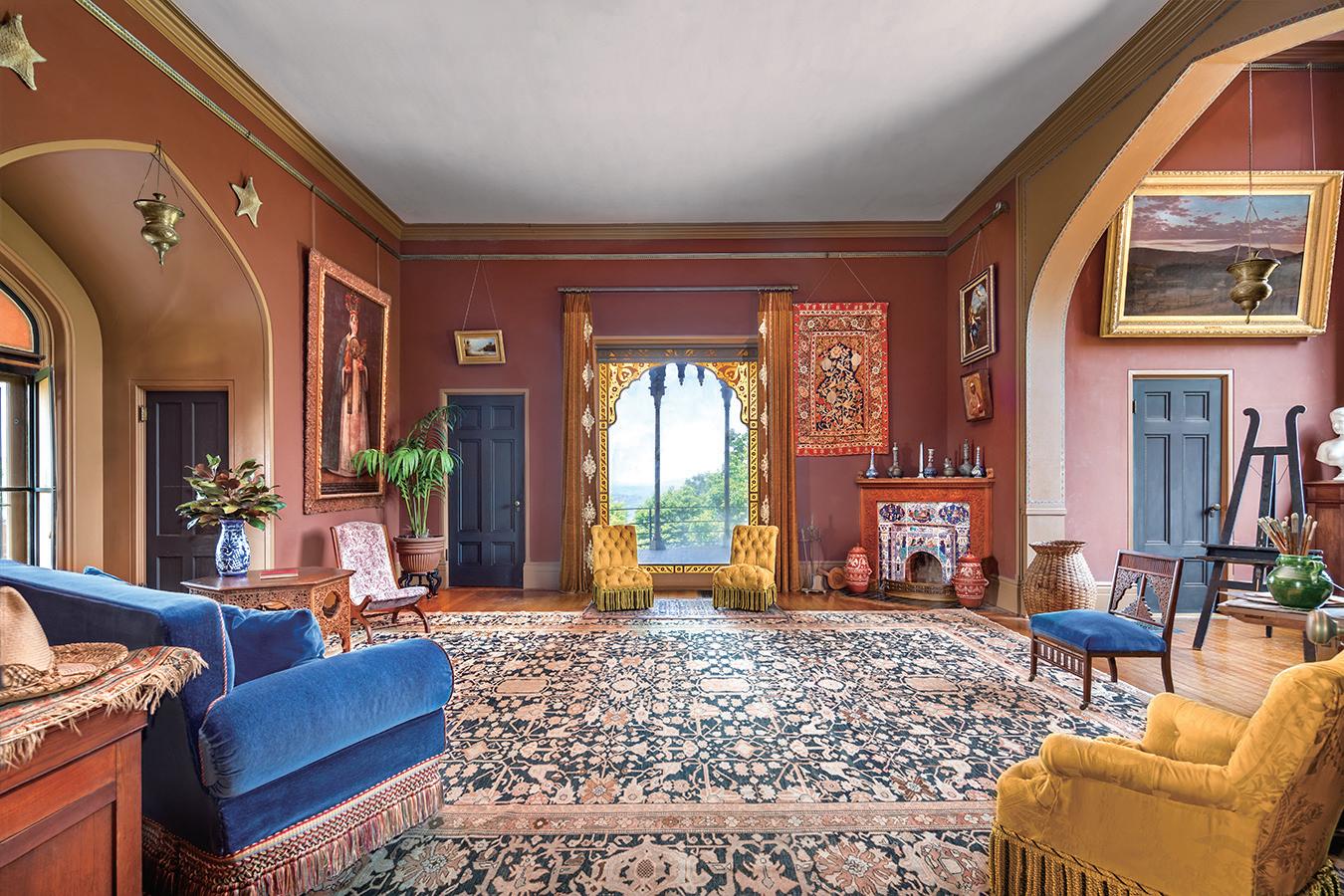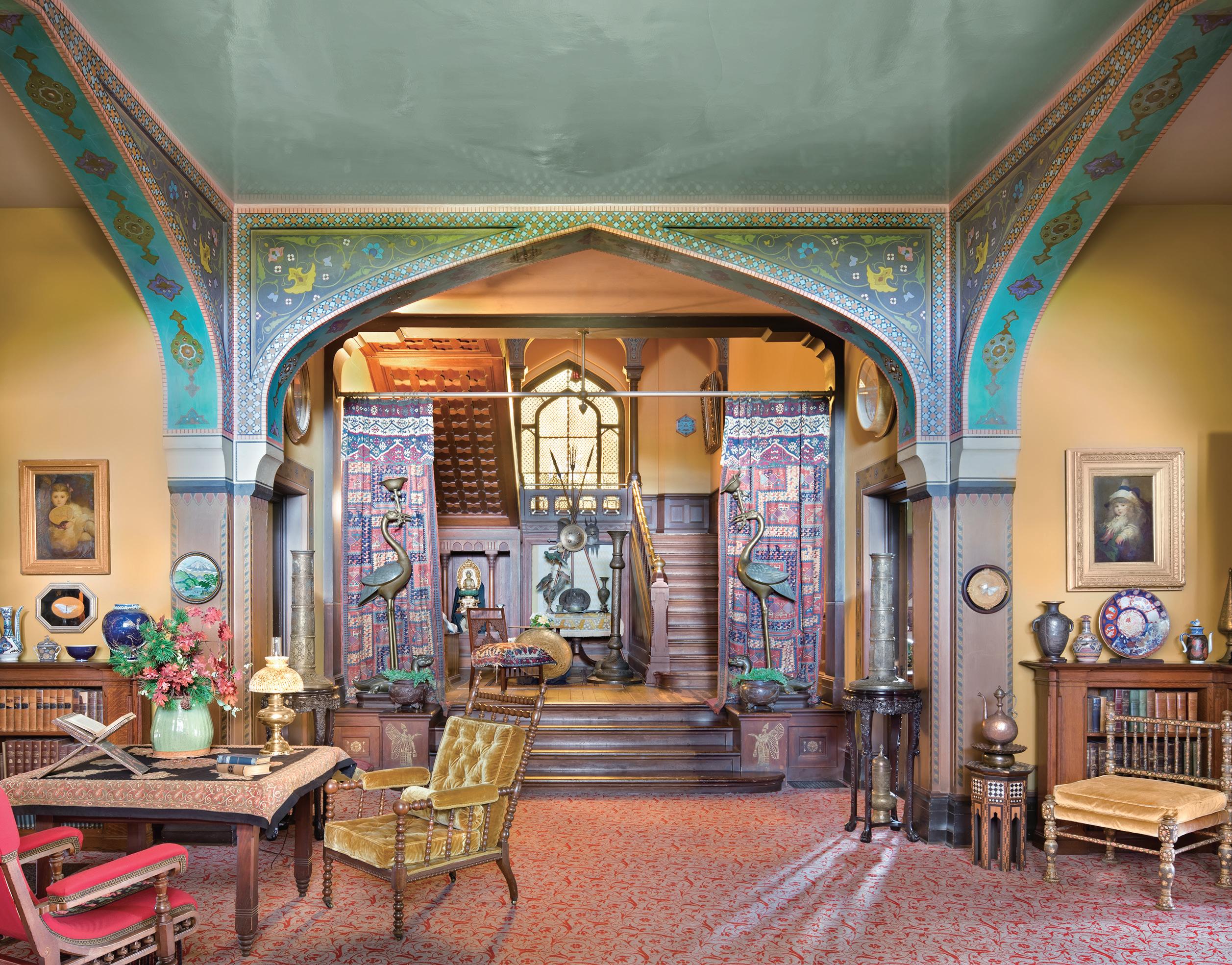
8 minute read
Olana: An Artist’s Beautiful Estate on the Hudson River
ELITE HOME
A Treasure on the Hudson River
Painter Frederic Edwin Church built Olana as his family's forever home 山坡上的立體「油畫」 名家最後巨作——愛邸歐蘭那
By Bob Kirchman Pictures courtesy of Olana State Historic Park
An aerial view south from Olana, with the Hudson River in the background.

On a ridge overlooking the Hudson River, artist Frederic Church composed his last, and perhaps grandest, work: a home and grounds for his family. He purchased the land above his first home, Cosy Cottage, before his trip to the Middle East and Europe. “I have just purchased the woodlot on the top of the hill. I want to secure [it] if possible before I leave every rood [measure] of ground that I shall ever require to make my farm perfect.”
Church’s vision was ambitious; not only did he want to expand his working farm, but Church also set out to create a foreground for the magnificent scenery in the distance—linking together a series of vistas with landscaped carriage roads. Church had formerly served as the park commissioner of Central Park and was fascinated with the possibilities of creating beautiful landscapes, working with the beauty already present in the natural world.
The hilltop that Church purchased was the same location that he and Thomas Cole visited when he was under Cole’s tutelage. The property overlooked Cole’s home on the Hudson River, and they would often walk there and sketch. Many of Church’s earliest works were inspired by the scenes from this particular site, and it was that very landscape that had started him in his work.
Though Church was once the most famous artist in America, his popularity (and career) waned in the 1870s. There was no longer a great demand for his large canvases, and commissions for his paintings of antiquities decreased in frequency. His rheumatoid arthritis also made painting more difficult. As the world forgot about Frederic Edwin Church, the great artist still had the means to devote himself to his family and the building of their amazing estate—a task he set about with great energy.
IN HARMONY WITH NATURE From his days exploring the Maine wilderness, Church was keen on integrating human activities harmoniously with unspoiled nature. He even included cottages and mills in his paintings of Mount Katahdin, though they did not exist. When he returned from his travels, he planted trees—more than 1,000 of them—and laid out the carriage roads. His property became the canvas upon which he began composing a living landscape. Church wrote of this process: “For several seasons after I selected this spot as my home,

Olana from the Southwest by Frederic Edwin Church, 1872. Brush and oil on thin paperboard. Gift of Louis P. Church, Cooper Hewitt, Smithsonian Design Museum, New York. _Courtesy of Cooper Hewitt, Smithsonian Design Museum
在一座能俯視哈德遜河畔的山脊上,風景藝術家弗雷德 里克 · 丘奇(Frederic Church)創造其人生裡最後、也 或許是最宏偉的作品——一座為家人而建的家園。 這棟建築所在之地,就位在他自家木屋的上方。他 在啟程前往中東和歐洲的旅途前,就已購入該地。「當時 我買下山丘上的那片林地,是因我想要確保每一項能使 我的農地更臻完美的元素,無一不漏。」丘奇有個遠大的 願景,他不只想要擴展農地,也想讓建築坐擁中心位置, 能與周遭的壯麗山景連成一氣。丘奇曾任紐約中央公園 的行政長官,因此他對如何將景觀設計與大自然的原始 美景結合,有著濃厚的興趣。 當丘奇還作為托馬斯 · 科爾(Thomas Cole)的學 徒時,便曾和柯爾一同造訪此山頭,那裡可以俯瞰科爾 的住處,他們時常走去寫生。當地的景色多是丘奇早期 創作的靈感,雖然丘奇曾是美國最知名的藝術家,但他 的人氣和其職業生涯在 1870 年代日漸衰退,大幅油畫 乏人問津,古物畫作的售價也不如以往。儘管如此,這並 不阻礙丘奇作為一名藝術家的創作,他轉而將其心力投 注於建造這座美麗的家園。
與自然唱合 丘奇格外熱衷於將人類的活動足跡融入大自然中,就像 他在卡塔丁山畫作中,加入了原本不存在的小屋和磨坊。 當他結束旅行返家後,種下了超過一千棵樹,並規劃四
THIS ARTICLE ORIGINALLY APPEARED IN AMERICAN ESSENCE MAGAZINE. Frederic Church translated the tile work, metalwork, and stone carvings of Islamic mosques into stencil patterns for the exterior and interior of the main house. “They say my final masterpiece was this house upon the hill.”


—Marc Cohn
In 1997, Olana was featured in Architectural Digest, where American singer-songwriter Marc Cohn picked up a copy and found inspiration. What Cohn discovered about Frederic Church motivated him to write the song he also titled “Olana.” “[Church’s] story about his family life and his creative life and his deep love for both resonated with me,” Cohn wrote. “Immediately after reading the article I started writing the lyric. As soon as I hit upon the idea of writing it in the first person—as Frederick Church—I was off and running.”
「他們說我人生中最終的傑作, 就是這棟山坡上的屋子」 ——Marc Cohn
1997年,一期《建築文摘》中, 刊載了「歐蘭那」的故事。美國詞 曲創作者Marc Cohn順手拿起
了雜誌,並從丘奇和歐蘭那的故 事中獲得靈感,創作了一首名為 「歐蘭那」(Olana)的歌曲。「丘 奇對於家庭與創作的熱愛,讓我 產生強烈的共鳴。在讀完關於丘 奇的文章後,我馬上投入創作該 曲歌詞。當決定以第一人稱創 作、把自己當成『丘奇』寫詞時, 我便飛速的完成了此作。


Left: The design for the sitting room at Olana was highly influenced by Frederic Church’s wife, Isabel. Her portrait hangs on the wall. El Khasné, Petra, one of Church’s large paintings, hangs over the fireplace. Right: Frederic Church’s studio at Olana was added to the main house between 1888 and 1890. The room displays custom wood designs by artist Lockwood de Forest. Great arched windows bordered by amber glass frame the views.
I thought of hardly anything but planting trees, and had thousands and thousands of them set out on the southern and northern slopes.”
New York architect Richard Morris Hunt had designed the Churches’ Cosy Cottage and was retained by Church to design the house on the top of the hill. Following the model for the Park Avenue homes he created for his wealthy clients, Hunt sketched out a building that was largely Victorian but a French château in style. Hunt went on to create George Vanderbilt’s vast Biltmore Estate in the mountains of North Carolina.
INSPIRED BY THE MIDDLE EAST Church had a different vision for his estate; his imagination had been stirred by a far more exotic muse. Awakened by his travels in the Middle East, Church found inspiration in Moorish and Persian designs. He asked his friend and architect Calvert Vaux (one of the designers for New York’s Central Park) to help him with the creation of this new vision. It was Church himself, however, who brought the project to life, and he fully immersed himself in building this masterpiece. He created scores of renderings as he experimented with Eastern motifs; tile patterns, intricate tile work, and screens flowed from his hands. The paint colors for the
輪馬車的專屬道路。他在自己的土地上自由揮灑,將風 景化作大型油畫。丘奇記錄了這個過程:「我選定此地為 家後的數年間都在一心一意地種樹,將數以千計的樹木 種在了南北兩側的坡地上。」 丘奇聘請了曾替他設計第一間木屋宅的紐約建築師 理查 · 莫里斯 · 杭特(Richard Morris Hunt)擔任他新 家的設計師。杭特以他在曼哈頓公園大道的一些高級公 寓設計案為基礎,規劃了一座帶有維多利亞風格的法國 城堡建築。杭特之後為 George Vanderbilt 設計建造了 位於北卡羅萊納州的畢爾特摩莊園(Biltmore Estate)。
異國文化的洗禮 但丘奇對新的家園懷有不同的願景,在中東的旅途中, 他親眼見識了非州摩爾和波斯的設計風格,激起他對異 國情懷的想像力。他尋求建築師朋友、紐約中央公園的 設計者之一卡爾弗特 · 沃克斯(Calvert Vaux )協助打 造他的理想。但最終還是透過丘奇自己全心投入,將此 計畫付諸實行。丘奇實驗性地將中東圖樣畫成一幅幅手 稿,磁磚上的圖案、繁複的磁磚拼貼、精巧的屏風隔板, 皆透過他的巧手完成,許多不同房間的刷色皆由他親自 調色。最終,建築保留了當初杭特設計的主體,並在沃 克斯和丘奇聯手下,成功讓這棟充滿異國風情的城堡, 落成於哈德遜河畔的山丘之上。丘奇家族將這座城堡命 名為「歐蘭那」(Olana),靈感來自波斯傳說中,可眺望 伊甸園的藏寶要塞。 這棟城堡建於 1870 至 1872 年間。丘奇親自參與設 計,因此建造期間,他向建築工匠耳提面命許多搭建的

Located at the center of the main house in Olana, the Court Hall is adorned with Islamic arches and a mix of decorations from the Middle East, the Americas, and India.
various rooms were initially mixed on Church’s palette. Though Hunt’s original massing of the house remained, Vaux and Church transformed it into a treasure palace from another land. The Churches named their palace Olana, inspired by a legendary Persian treasure house and fortress thought by some to overlook the Garden of Eden.
The house was built between 1870 and 1872. Church himself designed many of the details and taught the local craftsmen the correct way to build them. “A feudal castle, which I am building under the modest name of a dwelling house, absorbs all my time and attention. I am obliged to imagine Persian architecture, then embody it on paper, and explain it to a
細節。他表示,「(這座)僅以『住家』的名義建造,宛如 中心領地的城堡,投注了我所有的時間和精力。我必須 將腦海中的波斯建築繪於紙上,再向工匠解釋。」
以家為本 儘管室內裝潢直到1876年才完工,丘奇夫婦和四個孩子 早已先入住上層樓房。其夫人伊莎貝爾 · 丘奇(Isabel Church)在孩子年幼時選擇在家教育。夫妻倆以家庭為 生活重心,而他們也總是全家一起出外旅行。「歐蘭那」 成為弗雷德里克和伊莎貝爾共同持續創作的大型作品。 「有時候,想要建造的欲望讓我陷入狂熱的趕工狀 態。」丘奇曾如此描述他對這棟房子的熱愛。夫婦倆運 用他們的創造力和想像力,填滿其居家空間,用在歐洲 和中東旅行 18 個月期間的收藏品,點綴家中各個角落。
lot of mechanics.” Church often experimented with a variety of designs on paper before committing them to actual construction.
A FAMILY FOCUS The Churches and their four children moved into the upper floors even though the interior of the house was not completed until 1876. Isabel Church homeschooled their children when they were young. Family was the focus for both parents, and they always traveled together. Olana became the canvas that Frederic and Isabel Church continued to work on together.
“Sometimes the desire to build attacks a man like a fever, and at it he rushes,” Church said of his passion for the house. Together, he and Isabel created a space for their family to live in that reflected their creativity and imagination. They filled the house with furnishings acquired on their 18-month trip to Europe and the Middle East. Church obtained fine art by other artists and was even able to buy back some of his own work at auction. The house became a gallery as well as a celebration of the family’s life.
The dining room was a mixture of European and Middle Eastern styles, and Church selected copies of old masterworks to hang on its walls. Every inch of the house was filled with decorative art. Windows, framed by Persian motifs, opened upon magnificent views. In 1871, Church wrote: “The house will be a curiosity in architecture, and the picture from each window will be truly marvelous.” The eclectic decor was indeed an invitation to great conversations.
ENTERTAINING FRIENDS Though the Churches were forgotten by the world outside, they still entertained their many friends in their new palace. Author Samuel Clemens (Mark Twain) visited Olana and read poetry there. The day at Olana began with breakfast promptly served at 8 o’clock. After breakfast, the family and guests would gather in the sitting room for Bible reading before engaging in outdoor activities. Acres of wonder awaited discovery. In addition to being a working farm, Church’s landscapes provided endless vistas of the beautiful Hudson Valley. Lunch followed a full morning of activities, after which guests devoted themselves to quiet activities such as reading, napping, and letter writing.
Evenings would find the family and their guests gathered on the piazza to savor the views in the golden light. After dinner, there would often be recitations, tableaux, readings, and charades in the richly appointed court (center) hall. Don Wescott, narrator for a documentary about Olana, said: “The Church family home framed the living of daily life. It nurtured and protected their family.” The construction of the Churches’ estate also illustrated the journey made by Frederic and Isabel—a young couple that endured the death of their first two children and rose together to create a masterpiece home for their continued family to enjoy. Isabel passed away in 1899 and Frederic 11 months later. “Olana the house lives on as a wonderful curiosity, but Olana the home is so much more—it truly celebrates lives well-lived.
有時,丘奇會收到其他藝術家的創作,也會在拍賣會上 買回自己的畫作,因此,新居儼然成了一間美術館,對丘 奇一家的生活而言,有如一道祝福。 家中點綴著各式的裝飾品,如用餐空間融合了歐洲 和中東風格,丘奇選了一些大師的複製品懸掛於此空間。 用波斯式樣窗框裝飾的窗戶,往外正對著絕妙的景色。 丘奇在 1871 年寫下:「這棟房子將會成為建築學的珍奇 之作,每道窗戶放眼望去的畫面也將無與倫比。」如此兼 容並蓄的裝飾風格,自然會帶來各方人士的激烈討論。
會友日常 儘管丘奇一家未被不斷前行的世界所惦記,但他們仍持 續在這新天地款待好友。作家塞姆 · 克萊門斯(即馬克 · 吐溫)會造訪「歐蘭那」,並朗讀詩詞。通常,「歐蘭那」 的一天始於晨間8點,準時奉上的早點。餐後,丘奇家和 客人會先聚在起居室讀聖經,再進行戶外活動,周邊佔 數畝的大片土地可供探索。除了農場外,在丘奇的園內也 可欣賞哈德遜峽谷的壯麗。充實的晨間活動後,大家共 進午餐,隨之各自沈浸在自己的靜態活動中,例如閱讀、 小憩或寫信。 丘奇家和客人們在傍晚時會聚在露天廣場上,細細 品味太陽西夏的金黃時刻。晚餐酒足飯飽後,則多在富 麗堂皇的大廳進行朗誦、重現舞台場景、猜字遊戲等活 動。一部關於「歐蘭那」的紀錄片的旁白曾說:「丘奇一 家用日常的豐富活動來裝點他們的房子。它滋養並守護 著丘奇一家。」建造丘奇家過程也呼應了弗雷德里克與 伊莎貝爾的人生旅程:一對歷經兩次喪子之痛的年輕伴 侶,一同成長並共同為自己和下一代打造這間傑作。伊 莎貝爾在 1899 年過世,弗雷德里克於 11 個月後也隨之 離世。「歐蘭那」這棟建築本身已是美妙與驚奇滿載之 所,但「歐蘭那」作為一座家園,則承載更深遠的意義 ——它歌頌著這些豐富而充實的人生。



